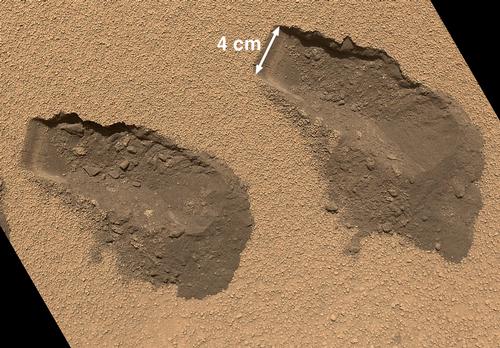Science News
Mars - Signs of Life?

The excitement in August of NASA’s Curiosity rover landing on the surface of Mars, inducing “seven minutes of terror,” is tricky to sustain four months into the mission. Instead of technologically savvy rocket engineering, now it’s all about the science—mostly chemistry, in fact. But last month, John Grotzinger, project scientist for the mission, generated a lot of interest by saying on NPR, “This data is gonna be one for the history books. It’s looking really good.”
But revealing those data had to wait until today, the first day of the annual American Geophysical Union (AGU) meeting here in San Francisco. And despite several reports that the news would be much ado about nothing, the press conference was held in a room almost ten times the size of the normal press conferences.
Of course, the biggest questions about Mars center around whether life exists on our nearest neighbor—or did it exist at some point in the past?
So, what did Curiosity find...?
A suite of Curiosity’s scientific instruments called SAM (Sample Analysis at Mars) has detected organic compounds in the soil… That’s the good news. However, those organic compounds have not yet been determined to come from Mars. Scientists must be very careful to ensure that these compounds are not the result of contamination from here on Earth. In addition, the researchers want to make sure that the chemicals truly originated on the Red Planet rather than from, say, cosmic dust.
Curiosity dug the soil from five different places at the Rocknest location—scooping just a few inches into the soil and sending it to different instruments within the rover. Curiosity’s team selected Rocknest as the first scooping site because it has fine sand particles suited for scrubbing interior surfaces of the arm’s sample-handling chambers. Sand was vibrated inside the chambers to remove residue from Earth. Funny to think that you can “clean” instruments with dirt.
Using mass spectroscopy, the SAM instruments discovered several chemicals in the soil, including water, carbon dioxide, oxygen, perchlorate, and sulfur dioxide. The carbon-based materials inspire the most caution in scientists. They want to make certain that these building blocks for life are indeed indigenous to the red planet.
So what next for Curiosity? It will drill at the Rocknest site and then move on to Mount Sharp, where more soil testing will potentially collect further clues about organic compounds on Mars.
Grotzinger reminded the packed press conference that, “Curiosity’s middle name is Patience.” And instead of seven minutes of terror, the true science mission is “three months of tension.” If not more… Stay tuned.
Image: NASA/JPL-Caltech/MSSS